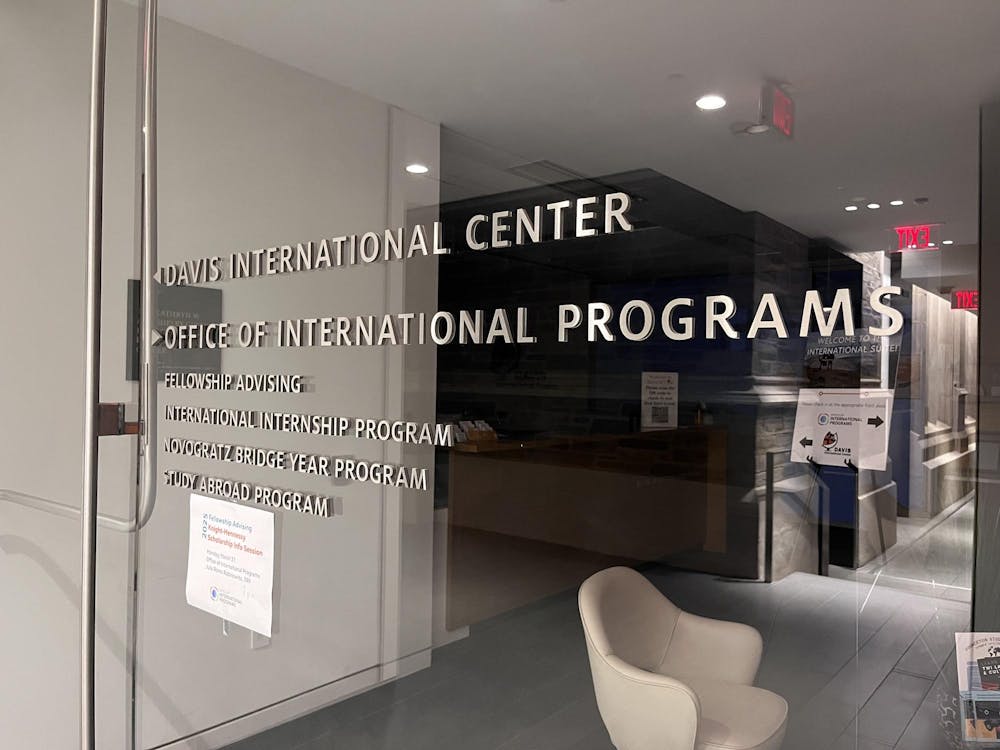The personal struggles behind Kashou’s professional success, which followed his achievements as a finalist on the reality television show “Project Runway,” formed the core of his talk at the Center for Jewish Life on Thursday. The lecture drew an audience of around 70 students and community members.
“I think design became the escape from a grim reality for me,” Kashou said. Growing up in Palestine, Kashou found attending school and socializing with friends to be the only activities available to him given “the politically complicated situation.”
“From that [experience] came this big dream,” Kashou said. “I will have a better life. I will become a fashion designer. No one will take away this dream I have.”
Born in Jerusalem, Israel, to a self-made business man and a former Miss Jordan, Kashou began exploring design as a young child with a series of recreational sketches he kept hidden from his parents. By the age of 14, Kashou had hundreds of sketches stashed away in tin boxes, known only to his cousin, who had similar design aspirations.
After his older brother exposed Kashou’s hobby to the family, however, Kashou found unexpected support, and he was asked to design ensembles for friends of his stepmother.
“To my surprise, they saw a talent [in me],” Kashou said. “I was surprised that they actually began to encourage me to do it.”
Kashou completed design courses in Cyprus after high school before moving to the United States. He said his decision to launch his career in the United States stemmed not only from the numerous fashion opportunities available, but also from the country’s cultural diversity and atmosphere of social acceptance.
“Where I’m from, [homosexuality] wasn’t something that was very common or talked about,” Kashou explained. “I told my parents that I needed to go to the U.S. so that I would be around a more diverse environment — allow myself to deal with personal things and continue design.”

Like many other members of the industry, Kashou’s road to achieving recognition in the fashion world was filled with obstacles, especially financial ones.
“There were times that were just difficult,” Kashou said. “One time, I had a write-up in The Los Angeles Times, and I didn’t have enough money to buy a paper. I saved every dollar to just buy fabric.”
The hours spent hunching over his wooden floor cutting patterns started to pay off, though, when boutique stores began to carry his recycled clothing line named “One of a Kind.”
“I would go to second-hand stores and bought oversized clothes and learned to put things together,” Kashou said. “I needed to creatively explode and work on pieces. I didn’t have a business plan or intern or work for anybody. I was kind of just surfing the wave of this dream.”

But even after several years of runway shows and designing for celebrities, Kashou still faced financial constraints. Some struggles “behind the closed doors” included collecting payments from well-known but bankrupt boutiques, and the unrealized costs of serving celebrity clients.
“Dressing celebrities is all free,” Kashou said, adding that celebrities bring potential future profit. “They do promote more sales. They have become human billboards of our work.”
Kashou viewed the competition on the fourth season of “Project Runway,” which challenges aspiring fashion designers’ ingenuity and personal aesthetic for prizes and fame, as a business opportunity to promote his work, which had limited exposure at the time.
“You have to play the game,” Kashou said. “Unfortunately, talent is not enough. There are a lot of talented people who are never seen because they are holding onto their art too much or not looking at the business side.”
“I could go and do really well and have a great show at Bryant Park, or I could be kicked off during the first round,” Kashou added. “I took a gamble. If you don’t take a gamble, you won’t get results.”
But Kashou’s gamble turned out to be a good one. Following his appearance on “Project Runway,” Kashou’s career — and revenues — took off, leading to commissions to design dresses for Heidi Klum and the queen of Jordan and a line for the Home Shopping Network. He also held a fashion show in Puerto Rico and has designed custom wedding gowns.
The show also had less tangible effects on Kashou. While the show’s environment offered minimal privacy, and the producers made a conscious effort to elicit dramatic reactions, Kashou said he believes the experience allowed him not only to share his passion and talent for design but also expose the large viewing audience to other pressing cultural concerns.
“Yes, on the show, we are creating fashion, but the show also sheds some light on some other areas as well, like me being Palestinian, this other guy being HIV positive and others’ issues,” Kashou said.
Alex Knezo ’09, who was familiar with Kashou and his work from “Project Runway,” said he appreciated Kashou’s willingness to engage students when they asked “more personal” questions.
“He talked about mostly his younger life, when he made paper dresses, and it was surprising because, where he is from, it isn’t as common for men to display feminine qualities in their work,” Knezo said.
Lauren Wong ’09, an architecture major, came to hear about how design fuctions in the fashion industry, but she said she was also intrigued by Kashou’s personal journey. “It was really amazing to hear his life story and how he made it with so little,” she said. “It was very moving and inspiring, and it made you really want to follow your passions.”
Kashou said he enjoys having the opportunity to open people’s minds to different ways of approaching the world.
“You usually see [Palestinians] on CNN, and we’re angry and stuff,” Kashou said. “People say to me, ‘We’re so happy to see a Palestinian face that is not like the faces we see in the media.’ ”







